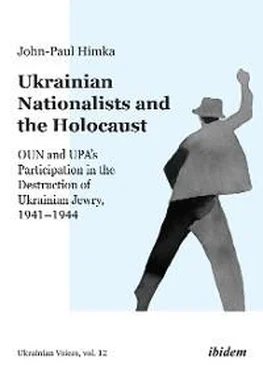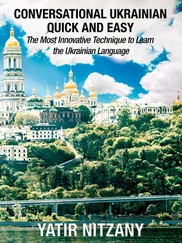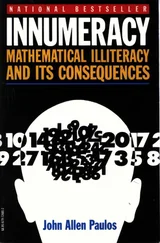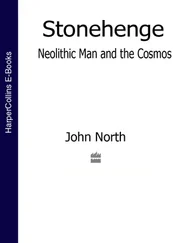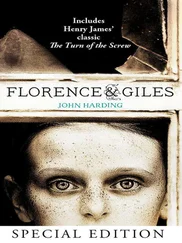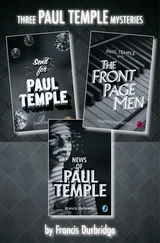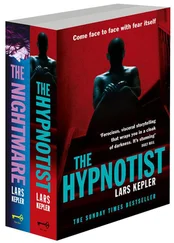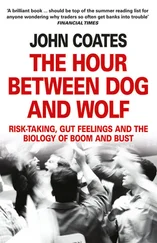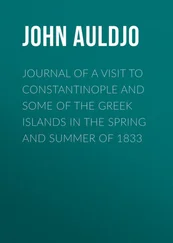The general validity of the information in Soviet interrogations was also accepted by the historical working group in Ukraine that provided the ammunition to rehabilitate OUN and UPA in the 1990s and early 2000s. Anatolii Kentii in particular used them for his work on OUN and UPA. Large extracts of these interrogations have also been published by the pro-UPA documentary series Litopys UPA .
Much of what has been said about interrogations also applies to Soviet trial records, but there are a few additional nuances. The records of trials, or simply of military tribunals, from the mid-1940s indicate to me that Soviet authorities in this era proceeded from some rough notions of justice—the courts and tribunals do not strike me as totally arbitrary. I was surprised, for instance, to discover in my research that accused war criminals, even members of OUN and UPA, were not convicted of murder on the basis of circumstantial evidence. There had to be eyewitness testimony or other evidence to convict. Thus, if an OUN militia executed a group of Jews in the summer of 1941, a participant in that execution could state that he was present at the execution but did not shoot; if none of his comrades betrayed him, he was likely to be convicted not of murder but of belonging to an anti-Soviet organization. A conviction of murder could result in execution, but participating in an anti-Soviet organization generally brought a sentence of ten years in a labor camp. Also, after the end of the Great Terror, i.e., from 1938 onwards, Soviet judicial proceedings became more professional and less arbitrary. 32
The other point to make about trials is that the records of the 1940s tend to be fairly brief. But sometimes cases were reopened later with an eye towards a deeper investigation of instances of mass murder, and these reopened cases produced quite voluminous files. An example is the case of Yakiv Ostrovsky a former Ukrainian policeman ( Schutzmann ) in Volhynia who deserted German service to join UPA. In July 1944 he turned himself into the NKVD and was interrogated by a famous Soviet partisan leader, Aleksandr Saburov. Over the course of his interrogation, Ostrovsky freely admitted to killing people as a policeman, but “not many—twenty-five to thirty people.” Yet when sentenced to twenty years of hard labor in 1945, he was convicted not of murder, but of treason (as a policeman working for the Germans) and of membership in a counterrevolutionary organization (UPA). The case, however, was reopened in 1981. I suspect this happened in the context of growing global interest in the Holocaust and the Soviets’ realization at that time of the propaganda value of linking Ukrainian nationalism to the murder of Jews. 33In any case, new evidence came to light that allowed Ostrovsky’s case to be reopened. It turned out that there had been an eyewitness after all to Ostrovsky killing Jews in an extermination action of 1942. The testimony had been recorded in July 1944, actually a day before Ostrovsky had turned himself in to the NKVD. But this testimony had been given not to the NKVD, but instead to the Extraordinary State Commission, the procedures and documents of which will be discussed immediately below. The lack of communication between the two Soviet investigative units meant that the relevant eyewitness testimony had not been considered at Ostrovsky’s original trial. The eyewitness was a non-Jew who had been forced to bury the victims of the execution action, some of whom were still alive as he buried them. He had named Ostrovsky as one of the shooters. Ostrovsky was put on trial again in 1982, and much more evidence was brought to bear; this time Ostrovsky was convicted of murder and executed in the following year. 34
Aside from investigation and trial records, another large collection of Soviet documentation relevant to our study are the documents of the Extraordinary State Commission for the Establishment and Investigation of the Crimes of the Fascist German Invaders and Their Accomplices, and of the Damage They Caused to Citizens, Collective Farms, Public Organizations, State Enterprises, and Institutions of the USSR. Established in 1942, its purpose was “to conduct investigations of Hitler’s war crimes and to determine the material damage suffered by the USSR, to coordinate the activities of all Soviet organizations in this field, to reveal the names of war criminals, and to publish official reports on their findings.” 35
There were two tendencies in the work of the Extraordinary State Commission that affected how OUN and UPA were represented in its documentation. First, the Commission was interested in ascribing as much destruction and murder to the Germans as possible, with the aim of receiving large reparations. Second, the Commission avoided disturbing the image of a united Soviet people that resisted the fascist onslaught. Both of these factors led to downplaying the role of local, non-German accomplices. For example, the Commission compiled a list of persons responsible for war crimes committed in Lviv. Of the 69 persons on the list, only 3 were non-Germans, 36although we know that the Ukrainian National Militia and later the Ukrainian Auxiliary Police were deeply involved in mass murder in the city. However, the Commission’s investigations at the local, i.e., raion, levels were more open to information about local collaborators in Nazi crimes. But when summaries of these reports were drafted at the oblast level, the activities of non-German accomplices were often edited out. The higher the level of summary, the lower the profile of non-German perpetrators.
Moreover, the Commission’s work was, as Solonari noted, “very uneven: in some districts it worked thoroughly, in others less so. Sometimes it could rely on relatively qualified personnel, but quite often barely literate party activists performed the entire task.” 37An example of the unreliability that Solonari describes appeared in the Commission’s investigation of a horrendous pogrom in Hrymailiv (P Grzymałów), north of Husiatyn in Ternopil oblast, in which many young Ukrainian men of the town participated. Relying on local witnesses, the Commission stated that SS officer Daniel Nerling participated in the pogrom, which occurred on 5 July 1941. 38However, as we know from Nerling’s trial in Lübeck in 1969, he did not arrive in Hrymailiv until late October 1941. 39
On the more positive side, as Solonari also noted, the Commission would sometimes “collect handwritten accounts of the survivors or eyewitnesses and attach them to their minutes or would transcribe verbal testimony that contained vivid descriptions of the killing operations.” 40As we have seen, one of the eyewitness accounts in a Commission report led to the reopening of the trial of the policeman Ostrovsky in 1981.
One aspect of testimonies recorded by the Extraordinary Commission and similar bodies was always marred by outright falsification, namely testimony that concerned crimes against humanity committed by the Soviets themselves. A disturbing case of this involved the historian Friedman. In 1946 he testified to both the Extraordinary Commission and the Commission for the Study of the History of the Great Patriotic War that the Germans had rounded up Jews when they took Lviv on 30 June 1941, shot them in prisons, disguised their nationality, and blamed the episode on the NKVD. Here are his exact words: “The destruction of the Jews in the city of Lviv began from the first day of the arrival of the Germans, that is, on 30 June 1941. Moreover, at the very beginning the Germans conducted this destruction as a provocation. Taking advantage of the withdrawal of Soviet forces, the Germans led a portion of the Jewish population to the prisons and shot them there....At the same time they pursued a second aim: to present this as an example of the ‘bestial crimes’ of the NKVD, which before its departure from Lviv was allegedly shooting political prisoners.” 41In his subsequent published scholarly work Friedman did not repeat the falsehood of a German provocation and correctly indicated that the corpses in the prisons were victims of the Soviets. 42Similarly, the Soviets recorded testimony of a captured German Wehrmacht officer, Erwin Bingle, that blamed the Soviet mass murders at Vinnytsia from 1936-38 on the German SS and Ukrainian police. 43Again, the murdered political prisoners were presented as murdered Jews. Bingle called the “frame-up” “baseless and utterly ridiculous.” 44Of course, the Soviets were unwilling to wash their bloody laundry in public but quite willing to add their own murders to the Germans’ account, so they induced testimony that served their purposes. This was part of a general policy, the most notorious incident of which was blaming the Germans for the mass murder of Polish officers and intellectuals in 1940 at Katyń.
Читать дальше
